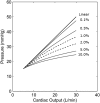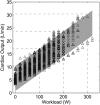Exercise-induced pulmonary hypertension: physiological basis and methodological concerns
- PMID: 23348976
- PMCID: PMC3733438
- DOI: 10.1164/rccm.201211-2090CI
Exercise-induced pulmonary hypertension: physiological basis and methodological concerns
Abstract
Exercise stresses the pulmonary circulation through increases in cardiac output (.Q) and left atrial pressure. Invasive as well as noninvasive studies in healthy volunteers show that the slope of mean pulmonary artery pressure (mPAP)-flow relationships ranges from 0.5 to 3 mm Hg.min.L(-1). The upper limit of normal mPAP at exercise thus approximates 30 mm Hg at a .Q of less than 10 L.min(-1) or a total pulmonary vascular resistance at exercise of less than 3 Wood units. Left atrial pressure increases at exercise with an average upstream transmission to PAP in a close to one-for-one mm Hg fashion. Multipoint PAP-flow relationships are usually described by a linear approximation, but present with a slight curvilinearity, which is explained by resistive vessel distensibility. When mPAP is expressed as a function of oxygen uptake or workload, plateau patterns may be observed in patients with systolic heart failure who cannot further increase .Q at the highest levels of exercise. Exercise has to be dynamic to avoid the increase in systemic vascular resistance and abrupt changes in intrathoracic pressure that occur with resistive exercise and can lead to unpredictable effects on the pulmonary circulation. Postexercise measurements are unreliable because of the rapid return of pulmonary vascular pressures and flows to the baseline resting state. Recent studies suggest that exercise-induced increase in PAP to a mean higher than 30 mm Hg may be associated with dyspnea-fatigue symptomatology.
Figures





Similar articles
-
Effects of body position on exercise capacity and pulmonary vascular pressure-flow relationships.J Appl Physiol (1985). 2016 Nov 1;121(5):1145-1150. doi: 10.1152/japplphysiol.00372.2016. Epub 2016 Oct 7. J Appl Physiol (1985). 2016. PMID: 27763874
-
Increased pulmonary vascular resistance in early stage systemic hypertension: a resting and exercise stress echocardiography study.Can J Cardiol. 2015 Apr;31(4):537-43. doi: 10.1016/j.cjca.2014.09.022. Epub 2014 Sep 28. Can J Cardiol. 2015. PMID: 25745880
-
Pulmonary vascular function and exercise capacity in black sub-Saharan Africans.J Appl Physiol (1985). 2015 Sep 1;119(5):502-7. doi: 10.1152/japplphysiol.00466.2015. Epub 2015 Jul 23. J Appl Physiol (1985). 2015. PMID: 26205542
-
Exercise-Induced Pulmonary Hypertension: Translating Pathophysiological Concepts Into Clinical Practice.Chest. 2018 Jul;154(1):10-15. doi: 10.1016/j.chest.2018.01.022. Epub 2018 Jan 31. Chest. 2018. PMID: 29382472 Review.
-
Clinical and research measurement techniques of the pulmonary circulation: the present and the future.Prog Cardiovasc Dis. 2015 Mar-Apr;57(5):463-72. doi: 10.1016/j.pcad.2014.12.003. Epub 2014 Dec 19. Prog Cardiovasc Dis. 2015. PMID: 25534670 Review.
Cited by
-
Pressure-flow responses to exercise in aortic stenosis, mitral regurgitation and diastolic dysfunction.Heart. 2022 Nov 10;108(23):1895-1903. doi: 10.1136/heartjnl-2022-321204. Heart. 2022. PMID: 36356959 Free PMC article. Clinical Trial.
-
Stress Doppler echocardiography for early detection of systemic sclerosis-associated pulmonary arterial hypertension.Arthritis Res Ther. 2015 Jun 19;17(1):165. doi: 10.1186/s13075-015-0673-7. Arthritis Res Ther. 2015. PMID: 26084934 Free PMC article. Clinical Trial.
-
Pulmonary Arterial Hypertension and Hereditary Haemorrhagic Telangiectasia.Int J Mol Sci. 2018 Oct 17;19(10):3203. doi: 10.3390/ijms19103203. Int J Mol Sci. 2018. PMID: 30336550 Free PMC article. Review.
-
Open label study of ambrisentan in patients with exercise pulmonary hypertension.Pulm Circ. 2017 Apr-Jun;7(2):531-538. doi: 10.1177/2045893217709024. Epub 2017 May 12. Pulm Circ. 2017. PMID: 28597763 Free PMC article.
-
Exercise Testing in Patients with Pulmonary Hypertension.J Clin Med. 2024 Jan 30;13(3):795. doi: 10.3390/jcm13030795. J Clin Med. 2024. PMID: 38337493 Free PMC article. Review.
References
-
- Cournand A, Bloomfield RA, Lauson HD. Double lumen catheter for intravenous and intracardiac blood sampling and pressure recording. Proc Soc Exp Biol Med 1945;60:73–75 - PubMed
-
- Fishman AP. Pulmonary circulation. In: American Physiology Society handbook of physiology: section 3. The respiratory system. Circulation and nonrespiratory functions. Vol 1. Bethesda MD: American Physiology Society; 1985. pp. 93–166.
-
- Rich S, Dantzker DR, Ayres SM, Bergofsky EH, Brundage BH, Detre KM, Fishman AP, Goldring RM, Groves BM, Koerner SK. Primary pulmonary hypertension. A national prospective study. Ann Intern Med 1987;107:216–223 - PubMed
-
- Badesch DB, Champion HC, Sanchez MA, Hoeper MM, Loyd JE, Manes A, McGoon M, Naeije R, Olschewski H, Oudiz RJ, et al. Diagnosis and assessment of pulmonary arterial hypertension. J Am Coll Cardiol 2009;54:S55–S66 - PubMed
Publication types
MeSH terms
Grants and funding
LinkOut - more resources
Full Text Sources
Other Literature Sources
Medical
Research Materials
Miscellaneous

